Goldfish is the magic heroine of Pushkin’s famous fairy tale about an old man and a wish-fulfilling fish. Many in childhood dreamed of having an aquarium with this fabulous creature at home. Someone, having matured and having lost faith in miracles, abandoned the childhood dream. Some, on the contrary, reaching for a fairy tale, began enthusiastically to keep goldfish at home, not expecting them to fulfill their desires, but receiving aesthetic pleasure, admiring their appearance.


Description
Goldfish, as a pet, has been known for over 13 centuries. The first domesticated "golden carps" appeared in China in the 7th century AD. The source of this was the craving for small animals that could be kept in small domestic ponds: ponds, wells, lakes or barrels of water. Particularly inclined to gathering was developed among the wealthy representatives of high society, since they had the greatest opportunity to decorate their yards with pools and artificial lakes.

A fabulous beauty was obtained by selecting individuals with a genetic mutation, and subsequently directed selection from ordinary silver crucian living in the waters of China, Japan and Asia.
In the natural environment, crucian carp, a representative of ray-fin fish from the cyprinid family, has a small, oblate, short and angularly tall body. The length of an adult can reach 30 cm, weight - about 350 g. Aquarium species of silver crucian carp are much smaller than wild counterparts and can have significant differences in body and head shape. The color of the dense, rough scales of the crucian carp is gray-green with a silver-metallic tint, but over the centuries of breeding, fish of various colors have been bred, ranging from yellow-silver to bright red and black with overflows.

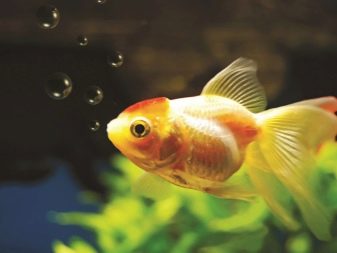
A decorative representative of the carp family lives 15–20 years, provided that she has created comfortable living conditions. In this case, the life span depends on the shape of the body of the fish: individuals with short bodies live much less than long-bodied counterparts.
Kinds
The species diversity of goldfish is grouped into subclasses that have similar shapes to the bodies, fin system, eyeball, scales, and color.
Body shape
Decorative crucian has such body varieties as:
- wild type - physically, the aquarium fish resembles its wild relative.
- torpedo - a fish that looks like a slightly flattened torpedo;
- egg - almost all modern decorative varieties of silver crucian can boast of such a body shape; the body expanded in the head region tapers slightly towards the tail;
- tear or drop - fish with an almost spherical body shape; in contrast to the ovoid form, the narrowing occurs from the tail to the head.

Fins
For many centuries of breeding breeds of goldfish were obtained with such types of caudal fins as:
- having the usual single tail, one into one similar to the tail fin of a wild fellow; such rocks are distinguished by the length or presence of dorsal fins, body size and color;
- having a double tail that has fused at the base, as well as double fins; differences between such breeds are in the size and shape of the body, tail, as well as various colors;
- in the latter type, the dorsal fin is completely absent, which is most often observed in fishes having the shape of an egg body; they have a smooth back, without any protrusions.

Eyes
Depending on the shape of the eyeball distinguish the following types:
- domed or hemispherical eyes protrude markedly from the sides of the head, which is clearly visible when viewed from above;
- the flat surface of the protruding part of the eyeball is characteristic of cylindrical eyes;
- round eyes or a globe - eyeballs in the shape of a ball protrude completely from the head and are typical mainly for telescope fish.

There are also such breeds with other characteristic features of the structure of the eyes, such as:
- stargazer - fish eyes have a spherical shape with pupils pointing up;
- water eyes or vesiculate eyes - have large eye glasses filled with lymphatic fluid; some varieties of such blisters have two pairs, one located directly below the eyes, the other a little lower, behind the lower jaw; eyes always look up.


Scales
Scaly fish cover has the following shades:
- brilliant;
- matte;
- pearl.

In addition, there are "scaleless" fish. The first representatives of such fish were obtained back in the 90s of the XVII century and belonged to the type of chintz telescopes.
Color tint
Among the many color combinations of goldfish connoisseurs and breeders distinguish the following types:
- monochrome - the fish is completely painted in one color, without other inserts;
- spotted (mottled) - such fish on the body have large spots of various colors and shades; for species with three colors, the name tri-color is used;
- with variegated scales - in such fish, each flake has two or more colors, which in total gives a characteristic "motley" body color;
- chintz - this color is characterized by a large number of small colored spots, partially overlapping one another; for fish with this color, it is desirable to have a large number of blue spots on the background of other colors;
- panda coloring - a fish of this type of coloring resembles the famous oriental bear, a lover of bamboo, not only in black and white, but also in a phlegmatic nature;
- "red Riding Hood" - a fish of this species is distinguished by the presence on the head of a growth that resembles the shape and color of the headdress of the heroine of a famous fairy tale.

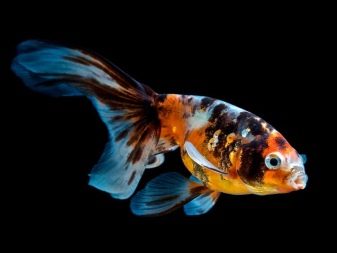


Varieties
For centuries of breeding more than 300 varieties of goldfish were obtained.
- Common. Aquarium fish of the wild type with a red-orange body color and a simple fin system.

- Butterfly. The fish got its name because of the bifurcated fluffy tail, which resembles the wings of a delicate insect, and the color forged non-ferrous metal. Jikin's eyes (Japanese "ingot") are domed.
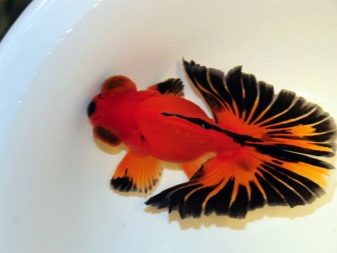

- Fantail. It looks like an ordinary goldfish with a slight difference: a short bifurcated tail is high or horizontal and in the open state resembles a fan.

- Veiltail. A small fish with an ovoid or spherical body has long fins and a tail-like tail, divided into 2–4 parts.

- Pearl. A small pot-bellied small fish with short fins is covered with scales resembling medium-sized pearls. The head is decorated with a small outgrowth hanging over the eyes.


- Comet. The elongated body and fins, as well as the single long tail outlines resemble a comet flying in the sky, for which one of the varieties of a goldfish got its name.


- Lionhead. A rather pot-bellied fish has growths on its head, giving it the appearance of a lion or buffalo head.


- The eye of heaven. The stargazer fish has a unique structure of eyes turned upside down, which makes it appear that it is constantly trying to examine the starry sky.


- Oranda. The lion-headed small fish has an ovoid body with elongated fins. On the head of the fish is a large growth.
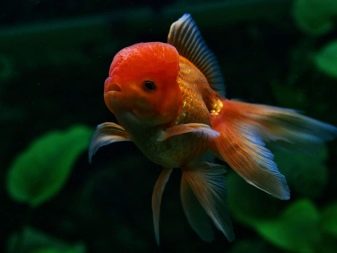
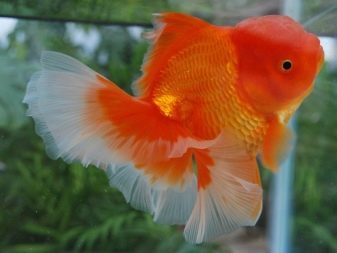
- Bubble eyes. Another individual with an unusual eyeball mutation. Under the eyes pointing upwards are leather bags filled with lymph. They can be single or double.


- The ranch. An egg-shaped fish without a dorsal fin is as if cast in an orchid, for which it got its name. Fish of this species have a shorter tail and fins, and there is also a small growth on the head.


- Ryukin. A very hunchbacked spherical individual with fluffy fins resembles a gold bar, hence its name "ryukyu", which in Japanese means "gold".


- Telescope. In ovoid fish with elongated fins, the eyes have the shape of a ball extending beyond the head. There are three subspecies of telescopes, namely:
- simple eyed;
- veil, with a long forked tail;
- black, with the color of a velvet dark night.


- Shubunkin. A very motley fish with an elongated body has transparent scales.


- Pompom. Short-bodied fish with an egg-shaped body has loose fleshy growths around the nostrils.
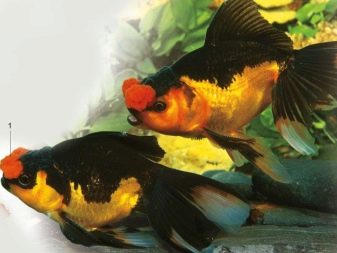

How to choose?
Goldfish have different body shapes, color and size, so first of all you need to decide which kind of goldfish you want to settle in the aquarium and enjoy it. And also determine the price, since many rare species are very expensive. Before starting an aquarium with a goldfish, the future owner needs to consider the following questions:
- where will the aquarium with the sorceress stand;
- how many individuals will live in an indoor pond;
- who will coexist with them on the same territory;
- for what purposes it was decided to keep a goldfish: just for the soul or for breeding, or the future owner decides to engage in breeding and try to develop a new type of ornamental carp.



How to name?
Some owners containing one or more fish give their pets personal names. Choosing a name for a fish, you can focus on the features of the tail, eyes, color, body shape: Big-eyed, White-tailed, Bubble, or something similar. Celebrate the name and features of behavior. For example, if the fish sleep a lot, then you can call Sonya or Sandman.

If individuals are more mobile in comparison with other fish of their species, name the car or Comet.
Since the word "gold" is associated with wealth, the names Archie, Bonnie, Jake and the like will suit aquarium phlegmatic people. Of the female names, you can use Cleo, Nefertiti, Lady. Since goldfish have their pedigree from the East, these beauties can choose names that have Japanese or Chinese roots, for example:
- Akemi (female) - bright beauty;
- Kiku (female) - Chrysanthemum;
- Akio (husband.) - handsome;
- Koheku (male) - Amber.


Giving a name to a goldfish is a simple task, it is limited only by the owner’s imagination. The name can be absolutely anything, starting from the usual human name, ending with various interesting names from different areas.
Content Rules
Goldfish is a rather unpretentious creature that can live for some time even in a small volume of water. In order for the fabulous beauty to live a long, healthy and fulfilling life, it is necessary to adhere to some rules of care and feeding.
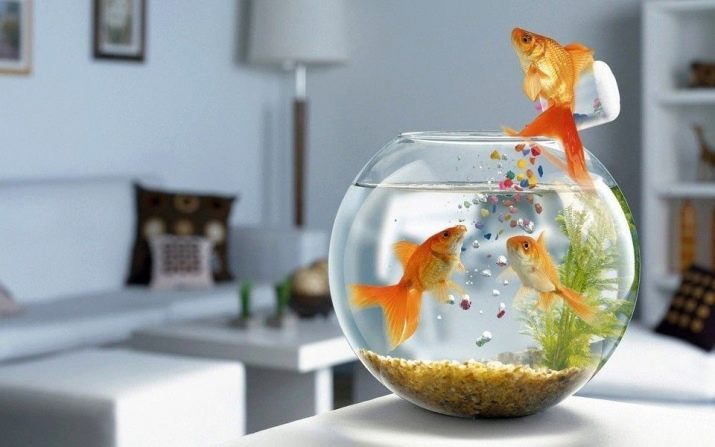
Aquarium Requirements
Preparing the aquarium for launch, Be sure to consider the following factors:
- a large amount of living space is important to a goldfish; the minimum requirement is 50 liters of water for a single copy;
- natural coarse sand or gravel soil;
- plants in pots with hard-to-reach roots and fairly hard leaves that cannot be gnawed (sagittaria, elodea, anubias, cryptocoryne, lemongrass, javanese moss);
- do not use artificial lighting, as the fish sleep at night, and for normal development, plants need sunlight;
- powerful filter for cleaning the soil - so that the aquarium becomes dirty as slowly as possible, you must install at least one internal filter of good quality; ideally, the aquarium should be equipped with two types of biofilters, the productivity of which will be at least 3-4 volumes of water in the aquarium per hour, while one will be located inside the aquarium space, and the other will be attached from the outside;
- the water temperature should be within + 20–25 ° С, while it should be noted that long-bodied individuals prefer cooler water, while their short-bodied brethren feel great at ambient temperatures up to + 27 ° С, but it is better if the water temperature will be a little lower;
- goldfish are demanding on the amount of oxygen in the water, so a compressor operating around the clock is required in the aquarium; the smaller the volume of the aquarium, the more powerful should be the saturation of water with oxygen;
- Another vital element for keeping fish is a sterilizer that destroys pathogenic bacteria using ultraviolet radiation.



In addition, the presence of plants in the aquarium ecosystem is very important for fish. They help fight algae, improve the ecology of water and can become an additional source of food and vitamins for the aquatic inhabitants themselves.that will positively affect their health and activity. If plants will be used as top dressing, they should have soft leaves. When choosing scenery, you need to consider that goldfish are not lovers of hiding in secluded corners, so they need a lot of free space for swimming. And also do not use decorations with sharp edges and various snags with protruding branches.

All protruding corners and knots pose a great threat to the integrity of the fins and scales of a leisurely resident of a reservoir.
Goldfish got dirty, therefore, in order to avoid severe pollution of their homes, it is necessary to replace water in the aquarium at least once a week by 25–33% of the volume, depending on the population density. Rinse the siphon sponge regularly in aquarium water and clean the bottom, being careful not to balamute the layers.Sometimes goldfish are kept in empty mono-aquariums without any vegetation or decoration.

Most often, for such purposes, use fish with lush veil tails.
Feng Shui Accommodation
Some lovers, deciding to start an oriental beauty house, attach great importance to how the location of a fish house should be in feng shui. According to the Taoist practice of arranging the space, an aquarium with fish should be placed in the hall near the entrance to the recreation area. It is not advisable to place a home for the goldfish in the bedroom, as it is a constant source of noise.


It is also necessary to determine the shape of the aquarium. According to the doctrine, irregularly shaped aquariums with sharp corners will not only not attract wealth, but may even harm health (including the opportunity to accidentally run into an acute angle). The ideal form for an aquarium, according to Feng Shui, is a ball. According to beliefs, the ball symbolizes the element of metal, and in combination with the water element, the spherical shape of the aquarium will literally become a magnet for acquiring wealth. The neutral shape is rectangular.
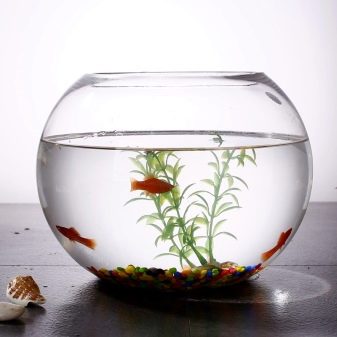

Besides, necessarily a certain number of fish. It is determined by what element is the patron of your zodiac sign according to the rules of the Chinese horoscope. For people born under the sign of water, it is worth getting 1 or 6 fish. The sign of fire will become a haven for 2 or 7 fish, a tree will grow 3 or 8, metal - 4 or 9, earth - 5 or 10. Feng Shui does not attach any importance to the species and breed of fish.
The pronunciation of the hieroglyph “fish” from the Chinese language is consonant with the hieroglyph “abundance”, so living in a house of a goldfish will definitely bring prosperity.
What to feed?
Fish feed is recommended with specialized feeds designed specifically for this breed or variety. When buying, you need to pay close attention to the integrity of the packaging, expiration dates, the reputation of the manufacturer, the purpose and composition of the feed line. The best choice is balanced cereal feed. Alternative to flakes are floating sticks and pellets (or nibs). And also the most popular food from a mixture of chips. Feed the fish 1-2 times a day in small portions (a pair of pinch per individual) in order to ensure the best digestion and reduce the risk of any disease.

And you should also change the feed, as in nature, these fish eat different foods.
From natural feeds for decorative carp, porridge from buckwheat, millet or oats is best suited. You can give finely chopped greens, such as spinach or salad, as well as vegetables and fruits. Fish eat well and live food: bloodworms, daphnia, artemia. If such feed is purchased frozen, then it must be thawed before feeding. Sometimes you can give finely planed meat and liver. Sometimes, with a frequency of a week or two, goldfish need to arrange a fasting day, when the entire menu will consist only of duckweed, wolfia or richchia.
Possible problems
Those who have been breeding goldfish for a long time know that the maintenance of artificially obtained miracles brings some problems, arising on such occasions as:
- water contamination by pathogenic bacteria introduced from outside;
- decrease in water quality due to the accumulation of ammonia, as a decay product formed during the life of fish and bacteria;
- weakening of the immune system of fish caused by poor living conditions;
- physical injuries that the fish get when the aquarium is improperly designed or the neighbors are incorrectly selected.

Signs of poor water quality include the following:
- yawning fish too often;
- the appearance of black spots on the body;
- bloody veins on fins and eyes;
- lethargy and too long finding the fish at the bottom;
- anxiety, gasping for air from the surface, scratching on stones.

To solve these problems, you need to change the water, establish the best system of purification and aeration, do not overfeed the pets. In addition to these problems, infectious diseases occur in fish, manifested in the form of white plaque or pimples, bloody ulcers, ruffling of scales. Antibiotics or antifungal drugs are used for treatment. Bloating indicates problems with the gastrointestinal tract, but may also be a consequence of an infectious or fungal disease. The cause of the disease is determined by concomitant signs. Accordingly, fasting days or medications are used for treatment.
If a small fish swims near the surface and puffs gill covers or tries to stay in a siphon stream, then there is the possibility of parasite damage to the respiratory system. To treat this type of problem, it is better to consult a specialist who will help you choose the drugs and give advice on the proper care of the sick fish. If the fish suffered losses in the tail, you should not be very upset. Put the sufferer in a separate container, and let him recover after the shock.
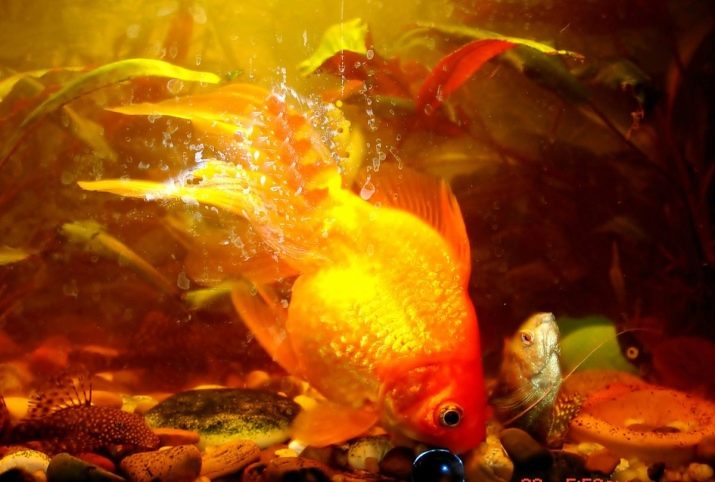
If the small place of growth is not damaged in the small fish, then after some time its fins and tail will grow back.
How to breed?
Breeding goldfish at home will not be particularly difficult even for beginners in the aquarium. The main thing is to know and observe several basic breeding rules.
- The main time for spawning of this species is spring, so you should carefully monitor the behavior and appearance of the fish in the general dwelling. With the onset of the mating season, males and females are covered with prosovid whitish growths on the gill covers, and their pectoral fins acquire saw-like notches. “Boys” are beginning to actively pursue females, driving those into dense thickets.
- The first step is to prepare a spawning aquarium (small, about 15 liters). To do this, add 80 eye drops of formaldehyde, 6 drops of copper sulfate and 1 small dose of terramycin to the water.
- Without drastic changes, start feeding fish with live non-granulated feeds, such as bloodworms or artemia. Feed the fish 3 times a day in small portions, the feed should be crushed.
- Simulate the onset of spring in the aquarium by lowering the temperature to + 10– + 12 ° C, and then gradually raise it to + 20– + 23 ° C, increasing the temperature by 2 degrees every day. Daily renew 20% of the water in the aquarium with the addition of a special conditioner that will clean the water from unnecessary and harmful elements.
- Choose the best specimens: the largest, fastest and most active male and female, which has large back and chest parts of the body. Next, you should put the male and two females in a prepared spawning ground. Spawning lasts about 6 hours, after which parents return to the main aquarium.
- Larvae will appear within 6 days. Initially, they will be fed by the residual yolk sac. Then they begin to feed, using special food for fry, which you can buy at the pet store or "live dust", brine shrimp or rotifers.
- When the fry grow up, sorting is carried out. This will allow to select individuals carrying parental traits, because not all of the brood will be similar to producers.


Compatible with other fish
Despite the fact that goldfish grow quite large, phlegmatic and clumsy, they are not able to coexist with many other species of aquarium fish. First of all, it is worth remembering that goldfish are omnivorous. Sharing small fish to them is just a way to create a source of additional food for goldfish. Do not combine in one aquarium gold or any excessively active or aggressive varieties. In this case, the goldfish will either be eaten (if size permits), or left hungry, or plucked, made from beautied fish, peeled monsters, or all together.
You should not lodge with gold the same large and slow fish, because the fish will completely eat all the poured feed, leaving neighbors without food.
It is impossible to settle gold fish and cichlids in one (even large) aquarium. Cichlids are aggressive, so at least there will be eternal aquarium races (if cichlids are large and herbivorous). But the common astronotus is happy to diversify its lunch with a goldfish. Theoretically, you can settle together goldfish and labyrinths. However, the labyrinth fish are very lively and restless, which implies constant stress for phlegmatic gold. It is possible to add to the gold the same calm ktenopom. But, given the tendency of the gold to dig, combined with the tendency to a near-bottom lifestyle by a ktenop, they are unlikely to survive such a long neighborhood.


Living together in a single aquarium of gold and hartsin is possible only in two cases: when the fish are still small or, if it is a large subspecies of hartsinovye (Congo or diamond). In any other case, the charcine will be for Gold a nice addition to breakfast. Goldfish get along only with some subspecies of cyprinids, such as zebrafish or labio. However, the rest of the small fish of the family, for example, parsing, our fish are not even averse to a meal. But Sumatran barbs are incredibly aggressive, with such cohabitation, goldfish will resemble plucked cocks, not bright beauties, since barbs love to attack any veil and bite them with fins.


Living in the same water area of some species of bottom catfish and goldfish is estimated by many professionals as positive. Such subspecies as cockroaches or corridors get along very well. They are slow, phlegmatic and will not see rivals in the golden beauties. But Antsistrus (aka catfish sucker) will not be a very pleasant neighbor, sticking at night to the gold and plucking them.
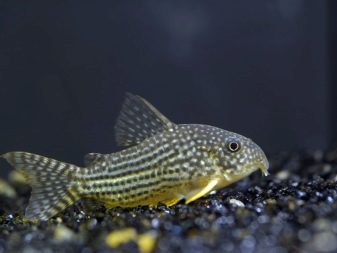
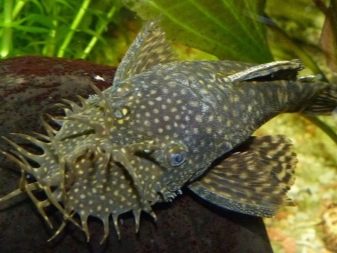
Some aquarium experts say that having a catfish as a neighbor will positively affect the general ecology of the aquarium, because the goldfish are incredibly dirty, they always have a lot of rubbish and waste left, and catfish are bottom cleaners by nature.
The compatibility of goldfish with other breeds of its kind is the highest. However, it should be borne in mind that all varieties of goldfish came from one common ancestor. If you miss the moment, there will be a degeneration of bright beauties-gold to the usual carp. Ideally, goldfish should not be combined with other species, leaving them to live with neighbors of the same breed.
Review Reviews
If you have decided to start a goldfish in the house, then you should prepare for the fact that the unpretentious beauty at first glance will turn out to be a rather capricious and demanding creature. Those who have already become familiar with this species acknowledge that for its proper maintenance and breeding, large, well-equipped aquariums, and it is better if they will belong entirely only to these leisurely beauties. The appearance of some fish does not cause pleasant aesthetic feelings in everyone, but this does not stop returning to them again and again, even if it was decided not to contact them anymore. With poor maintenance, the fish are often ill and require a lot of time for treatment and further care.
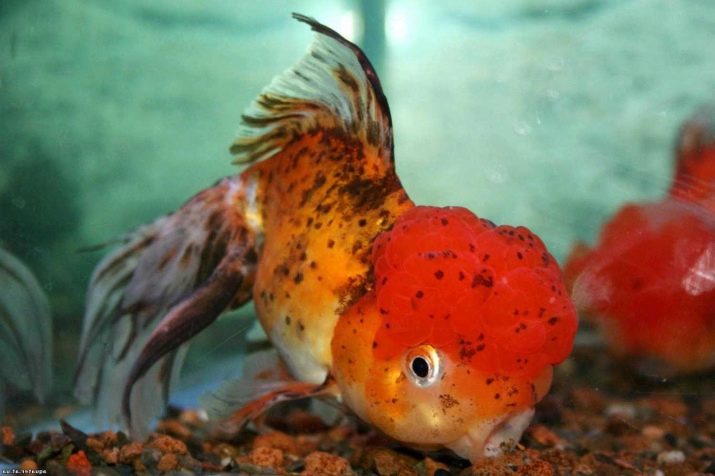
But despite the problems that arise, goldfish owners acknowledge that the fish are worth the effort.
Tips
The following aspects should be highlighted. goldfish content:
- the aquarium for one fish should have a volume of about 80 liters, for a couple - at least 100 liters;
- the length of the aquarium should be two times the height;
- the fish house must be equipped with a high-quality filtration and aeration system;
- water hardness not less than 8 °, pH - 7 units;
- to design an aquarium, you should use a lot of living plants and natural soil;
- scenery should not have sharp ledges and corners;
- the right choice of neighbors will ensure the peaceful existence of the entire ecosystem;
- timely cleaning of the aquarium and replacing water will preserve health and prolong the life of your pet.

And the most important thing is to be attentive to your goldfish, notice the slightest changes in behavior and appearance, react to them in time, then it will delight you with its beauty for a long time.

In the next video, watch interesting facts about goldfish.










